ISLE 0F MAN 1986 "THE MANX MUSEUM 1886-1986"
| <prev | back to index | next> |
| Issue Date | 05.02.1986 |
| ID | Michel: 302-306; Scott: 301-30 ; Stanley Gibbons: 310-31 ; Yvert et Tellier: 297-301 ; Category: pR |
| Design | J. H. Nicholson, R.l., P.S. |
| Stamps in set | 5 |
| Value |
12p - Viking Necklace 15p - Meayll Circle 22p - The Great Deer (Cervus Giganteus) 26p - Viking Longship 29p - Cregneash |
| Emission/Type | commemorative |
| Issue places | Douglas |
| Size (width x height) | 28.45 x 42.58 mm |
| Layout | Issued in sheets of 40 stamps (2x20) |
| Products | FDC x1 |
| Paper | 102 gm unwatermarked PVA gum security coated |
| Perforation | 14 x 14 |
| Print Technique | Lithography |
| Printed by | The House of Questa, London |
| Quantity | |
| Issuing Authority | Isle of Man Post Office |
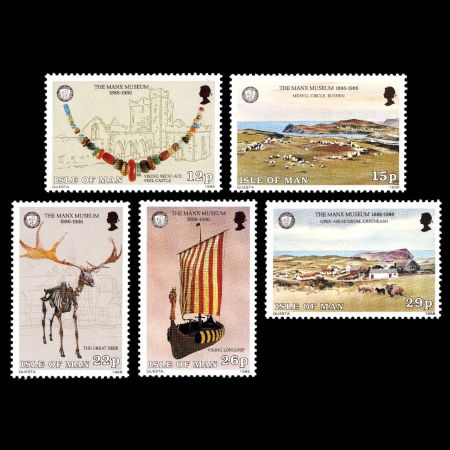
On February 2nd, 1986, the Post Authority of Isle of Man issued a set of 5 stamps to commemorate 100th anniversary of "The Manx Museum"
The Manx Museum is the treasure-house of
the Manx people and the headquarters of the Manx National Trust and of
the branch museums at Castletown (Nautical Museum), Cregneash (Village
Folk Museum), and Ramsey (Rural Life Museum).
Totally distinctive in character, it is devoted to the Isle of Man in
all its aspects and extends from prehistoric times right up to the
present day. In 1986 ISLE 0F MAN POST OFFICE commemorate the Centenary
of the Manx Museum and Ancient Monuments Act (1886) by which Tynwald,
the Island's Parliament, recognised the need for official preservation
of the Island's history.
In 1922 the early work of the Manx Museum
Trustees was centralised by the provision of land and buildings,
through the generosity of the Trustees of the late Henry Bloom Noble, a
wealthy Manx philanthropist. Since that time, extensions and
development have increased the public and records areas. A new Art
Gallery and Library were opened in 1936, a Natural History Gallery in
1937, and in 1960 further space was provided for the Museum's Library
and Archives. The latter holds an unrivalled collection of Manx public
records, private archives, newspapers, photographs. prints and maps, as
well as printed books of Manx and general reference.
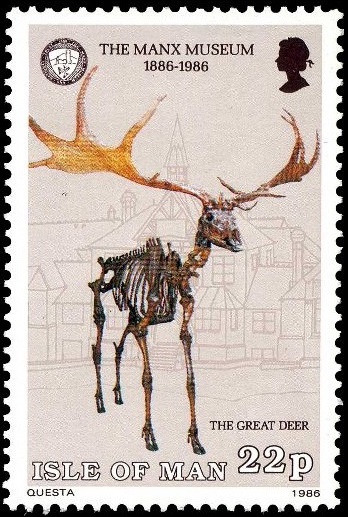 |
| Skeleton of Great Deer on stamp of Isle of Man 1986, MiNr.: 305, Scott: 303. |
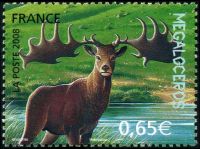
|
| Reconstruction of Megaloceros giganteus on stamp of France issued in 2008, MiNr.: 4404, Scott: 3432. |
One stamp from the set, with face value of 22p, depicts a skeleton of "The Great Deer" (Megaloceros giganteus). These animals were inhabitants of Man at the close of the Great Ice Age and became extinct in prehistoric times.
Megaloceros giganteus, also known as "Giant Deer" or "Irish Elk" (even though it is not an elk, nor it unique to Ireland).This deer, contemporary of the Mammoth and wooly Rhinoceros, was indeed a Giant, as males were up to 700 kg in weight and stood about 2.1 meters tall at the shoulders. They carried proportionally huge antlers with a maximum tip to tip length of 3.65 meters.
The antlers were up to 50 kg in weight, which are the largest antlers of any known deer. Similar to modern deer, the female animals were smaller and antlerless, while males replaced their antlers every mating season.
According to the recent research Megaloceros giganteus, most closely related to the living fallow deer (Dama dama).
They lived during the Pleistocene Epoch, between 2.6 million years ago and 11,700 years ago in in Europe and Asia. A small population of Megaloceros giganteus survived in the Siberian region of Russia until 7,000 years ago (probably even to more recent time).
The very first, nearly, complete skeleton of Megaloceros giganteus in the world was found not in Ireland, but on the Isle of Man.
It was in 1819 when a man called Thomas Kewish discovered it in a marl pit (by "marl” is usually meant an open-water mud rich in calcium carbonate deposited principally by the plant Chara. Such a mud gives clear evidence of the former existence of a lake in whose calcium-rich deposits bone would be readily preserved) at Loughan Ruy, a basin on the Ballaugh gravel fan, Isle of Man.
Only a few bones are missing in the skeleton, most notably the pelvis. Kewish used a large horse pelvis, among a few other things, to fill in the gaps. Kewish entered into a partnership with James Taubman, the tenant of the field where the fossils came from. They placed the mounted skeleton on display and charged admission to view it.
The Duke of Athol, who was the Queen’s Representative on the Isle of Man, later claimed the fossils as Lord of the Manor. After a lawsuit, the elk came into the Duke’s possession.
The Duke of Athol later gave the specimen to the Museum of the University of Edinburg. The Elk was later transferred with other specimens to the National Museum of Scotland on Chambers St, Edinburgh.
As it was the first skeleton of Megaloceros giganteus its drawing appeared in many scientific essay and books.
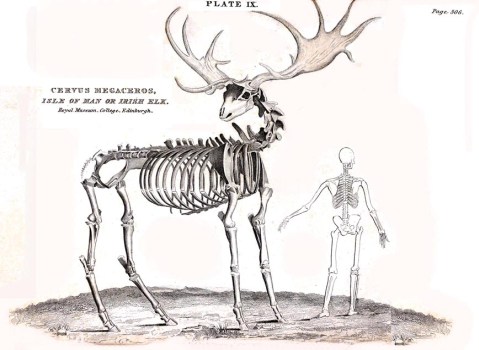
|
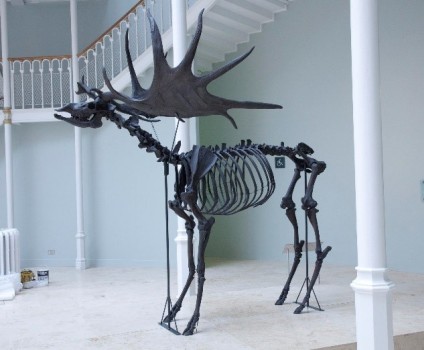
|
| The drawing of Irish elk from Isle of Man from a book “Essay on the THEORY OF THE EARTH, BY Baron G. Cuvier” published in 1827 | The skeleton of Megaloceros giganteus from Isle of Man on display in the National Museums Scotland. The image is from the website of the Museum |
Today it is required to have an export license to remove Giant Deer bones from the Island, but it is almost impossible to obtain one.
The only other skeleton of Megaloceros giganteus found on the Isle of Man, to date, is the one shown on the stamp, was excavated at Close-y-Garey, St. John's in 1897, as the result of an intensive search for a complete specimen by the 'Elk Committee' led by P.M.C. Kermode, who later became the Manx Museum's first Curator. The skeleton is almost complete; the back of the skull and tail were missing at the time of excavation and have been replaced by modelled plaster. Two large neck bones were also missing and the gap filled by Irish bones supplied by the British Museum.
This skeleton is 1.7 metres tall at the shoulder, with an antler span of over 2.6 metres.
It was originally displayed in the temporary museum at Castle Rushen in 1905 before being transported to the Manx museum in the 1950s.
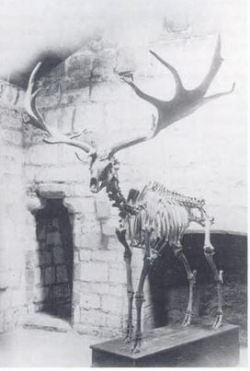
|
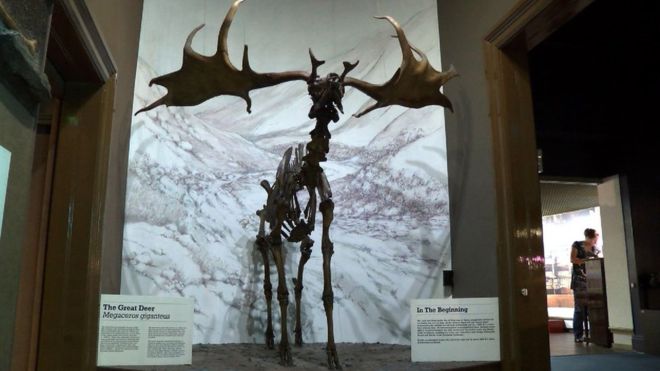
|
| Mounted skeleton of Megaloceros giganteus the temporary museum at Castle Rushen (1905-1950), The image is from Wikipedia website | Mounted skeleton of Megaloceros giganteus in the Manx Museum (1950-now). The image is from BBC website |
The collection of Megaloceros giganteus bone in the "Manx Museum" of Isle of Man is no way near as extensive as the one in Dublin, but bones turn up fairly regularly on the north-west coast and we have a few nice pieces, as it happened in the Spring of 2018 for example:
|
12p value - Viking Necklace. Peel Castle offers rich testimony to the vicissitudes of Manx history through the centuries, from the early Celtic inhabitants through the age of Viking supremacy to the Stanley period. Since 1982, careful excavations, initiated by the Manx Museum and now supported by St. Patrick's Isle (Isle of Man) Archeological Trust, have revealed many treasures from the past, and give promise of valuable and exciting discoveries in the future. This spectacular necklace, originally consisting of over 60 glass and amber beads, was found with other household goods in the Pagan Lady's Grave - the first female Viking grave discovered in the Isle of Man. |
15p value - Meayll Circle. This megalithic chambered tomb is of a unique design. It consists of 6 pairs of burial chambers arrayed in a circle, with a passage leading inwards to the junction of each pair. First recorded in 1863 and first excavated in 1893, it is believed to date from the New Stone Age, around 2,000 BC. |
|
26p value - Viking Longship. The arrival of early Viking raiders and their subsequent settlement made an enormous impact on the Isle of Man. This large-scale model, now on display in the Museum, was specially constructed in Norway in 1939 and is a faithful reproduction of the famous ship discovered at Gokstad, Norway, in 1880. |
29p value - Cregneash. This village, preserved as a monument to the activities and environment of Manx people in bygone years, was the first publicly-owned open-air Folk Museum in the British Isles. The original buildings, some furnished as dwellings and others bearing evidence of traditional crafts, faithfully reflect the lifestyle of one of the last strongholds of Manx custom and tradition. |
Products
| FDC | ||
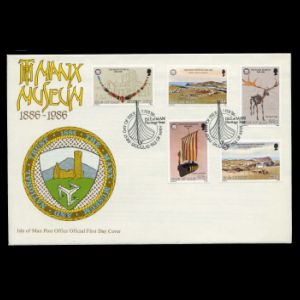 |
|
|
References

|
- Technical details and stamps presentation:
Inside text of FDC; -
Manx Heritage Museum:
official website -
Discoveries of Megaloceros giganteus on Isle of Man and Ireland
- "First discoveries Megaloceros" by Michael Kogan (the author of this website) and Dr. Peter Voice, PhD Department of Geological and Environmental Sciences, Western Michigan University, USA.
- "Taxonomic problem of the giant deer Megaloceros giganteus"
- "Cervus giganteus in the Isle of Man"
- "The Giant Deer in Ireland" (Studies in Irish Quaternary Deposits: No. 6)
- General information about Megaloceros giganteus
Acknowledgements:
- Many thanks to Dr. Peter Voice, PhD Department of Geological and Environmental Sciences, Western Michigan University, USA, for his help in finding information and for review of a draft of this article.
- Many thanks to Mrs. Laura McCoy, Curator of Natural History in Manx Museum of the Isle of Man for her help in finding information for this article